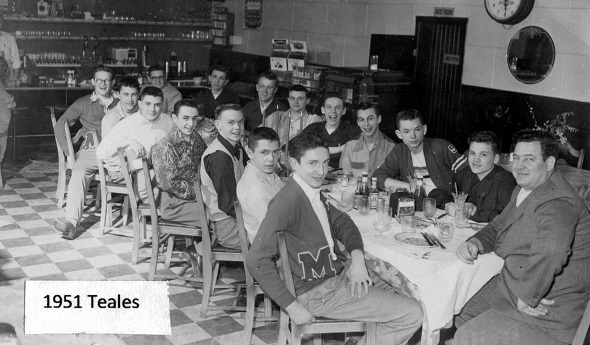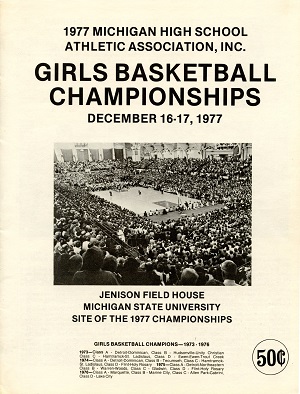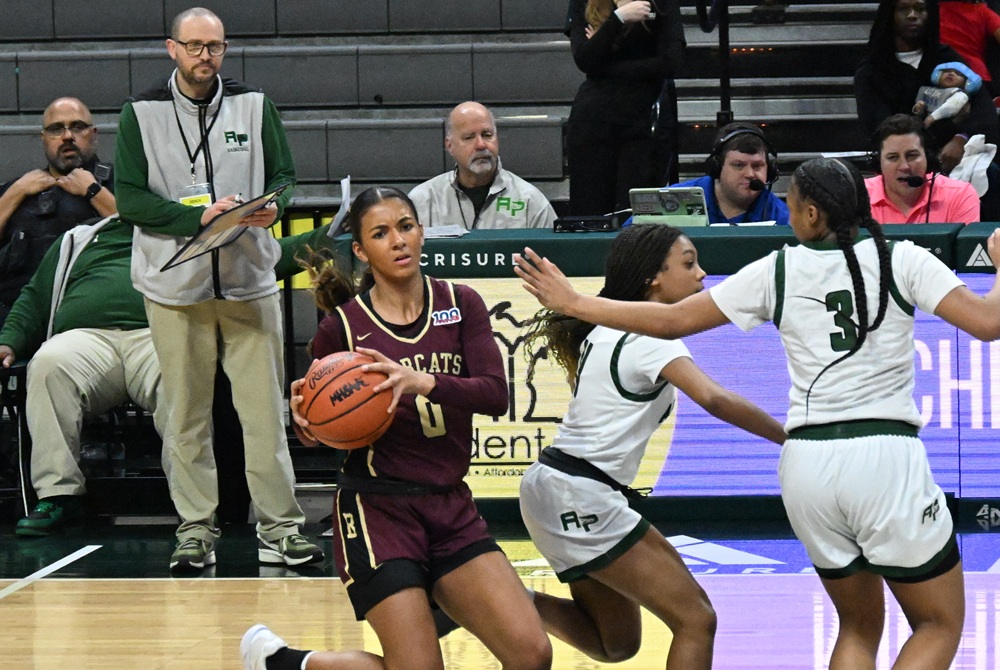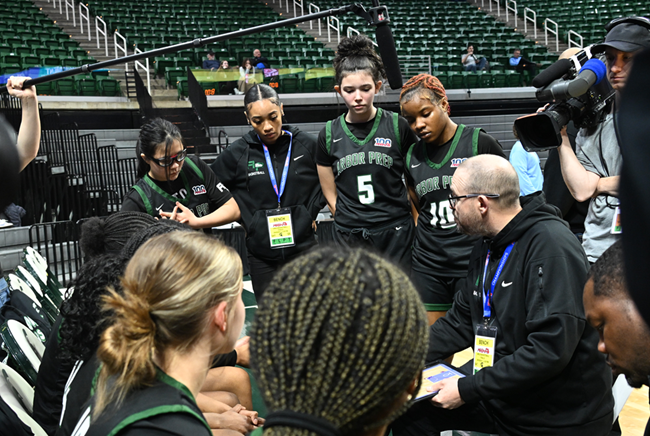
Data Dig Continues for Hoops Histories
March 7, 2017
By Ron Pesch
Special for Second Half
There is a list – well actually two – that sit, unfinished, among the “1,001 Projects I’d Like to Complete Before I Die.”
I became the caretaker of these lists back when I inherited the title “Historian for the MHSAA” in 1993.
The original lists contained the scores of all MHSAA Quarterfinal, Semifinal and Final round games for the MHSAA boys and girls basketball tournaments since their origin.
From the 1930s into the late 1960s, the MHSAA tournament game-day program was generally nothing more than a single sheet document, containing tournament brackets and team rosters for the qualifiers.
 In 1969, the program saw a redesign by Lansing sports personality Tim Staudt and premiered at the MHSAA Tournament. Sold for 50 cents, it included a list of “Past Michigan State Champions” containing the names of the winning teams and those schools’ basketball coaches for each of the four classes. The publication also included a couple of articles from Dick Kishpaugh, the author of the champions list. Kishpaugh was identified as “Sports Information Director at Kalamazoo College and … perhaps the most knowledgeable historian on Michigan high school basketball.”
In 1969, the program saw a redesign by Lansing sports personality Tim Staudt and premiered at the MHSAA Tournament. Sold for 50 cents, it included a list of “Past Michigan State Champions” containing the names of the winning teams and those schools’ basketball coaches for each of the four classes. The publication also included a couple of articles from Dick Kishpaugh, the author of the champions list. Kishpaugh was identified as “Sports Information Director at Kalamazoo College and … perhaps the most knowledgeable historian on Michigan high school basketball.”
With the start of the Girls Basketball Tournament in 1973, a similar program design was followed.
Those lists were faithfully updated and published in the game-day programs in the same format until the 1987-88 school year, when the souvenir publications were expanded. For the first time, a list containing opponents and final scores of the boys and girls championship games was now available to the general public.
Among the first tasks I chose to approach when I assumed the duties of MHSAA historian was to chase more information.
Since Kishpaugh’s lists had game scores for the three final rounds of the tournament, and names of the championship coaches, I thought I would try to leave my mark. I began chasing down the names of coaches for the runner-up, as well as final win-loss records for both schools. And while I was at it, I decided to see what I could find for teams that made the Quarterfinals and Semifinals.
Hundreds of hours have gone into adding to and maintaining the lists, and much progress has been made. Yet, some 20+ years later, I’m still trying to fill holes in the data.
The Basketball Coaches Association of Michigan helped spread the word, notifying its membership of the project. Web pages were created for both the boys and girls to show teams still missing information.
 The pursuit has led to friendships, and fascinating stories, documents and images. The late Walter Michael, who had attended the MHSAA Finals for more than 60 years, donated a cache of MHSAA tournament programs from the 1940s through the 1960s that filled in the names of many high school coaches. Del Newell, a sports writer from the Kalamazoo Gazette, knocked out most of the Kalamazoo schools early in my search. Bill Khan, then of the Flint Journal sports department, filled in a large number of missing names and records from the Flint area. The recently retired “Son of Swami,” better known as Mick McCabe, contributed by including the win-loss records of the quarterfinalists in his annual tournament prognostication columns for the Detroit Free Press.
The pursuit has led to friendships, and fascinating stories, documents and images. The late Walter Michael, who had attended the MHSAA Finals for more than 60 years, donated a cache of MHSAA tournament programs from the 1940s through the 1960s that filled in the names of many high school coaches. Del Newell, a sports writer from the Kalamazoo Gazette, knocked out most of the Kalamazoo schools early in my search. Bill Khan, then of the Flint Journal sports department, filled in a large number of missing names and records from the Flint area. The recently retired “Son of Swami,” better known as Mick McCabe, contributed by including the win-loss records of the quarterfinalists in his annual tournament prognostication columns for the Detroit Free Press.
Numerous coaches around the state sent e-mails and letters with the names and records for their predecessors. Prep basketball fans and former players sent along offerings. Rob Madsen from Mt. Pleasant became a huge contributor, and sent regular updates to both lists. He focused on some of the state’s smallest schools, including many from the Upper Peninsula.
Leon Westover sent the win-loss record for little Marlette, 1951 Class C runner-up, as well as one of my favorite photos from that golden era of prep sports. Marlette had “waltzed through the Mid-Thumb League and district, regional and quarter-final tournament games,” wrote Fred J. Vincent of the Port Huron Times-Herald. Marlette slipped past Stanton 41-37 to advance to the Class C title game against unbeaten Detroit St. Andrew.
“Just one game too many …,” continued Vincent, writing from East Lansing’s Jenison Field House following the title game. “That just about explains the one-sided beating Marlette absorbed in the state class C high school basketball final here Saturday afternoon. The final score was 52-26. … One of the smallest teams, physically, in the tournament, it seemed that the Raiders were just worn out.”
Yet, that night, the team was celebrated like the hometown heroes they really were.
 Westover’s photo shows the Red Raiders on the night of the Final, gathered at Teale’s Restaurant in Marlette. The clock indicates its 11:30. The owner, George Teale, has opened up his restaurant for the team to cook them steaks in honor of their achievement. Coach Nieland "Tommy" Thompson and his 22-2 squad look happy, ready to celebrate a long season.
Westover’s photo shows the Red Raiders on the night of the Final, gathered at Teale’s Restaurant in Marlette. The clock indicates its 11:30. The owner, George Teale, has opened up his restaurant for the team to cook them steaks in honor of their achievement. Coach Nieland "Tommy" Thompson and his 22-2 squad look happy, ready to celebrate a long season.
At tournament time, these lists help answer media requests that arise.
Question: When was the last time two undefeated teams met for an MHSAA Finals championship?
Answer: 2003-Class A for the girls. Detroit Martin Luther King topped Flint Northern 58-53. 1971-Class C for the boys. Shelby downed Stockbridge 71-57.
Question: What coach had the longest span between championship game appearances?
Answer: Eddie Powers, coach of Detroit Northern, went 34 years between his Class A championship team in 1930 and his runner-up squad in 1964. The mark is asterisked, however, as the Detroit Public School League chose to stop participation in the annual state tournament from 1931 through 1961. Saginaw’s Larry Laeding went 20 years between winning the 1942 Class A championship and his squad’s 1962 Class A title. Maple City Glen Lake coach Don Miller went 19 seasons between the school’s 1977 Class D title and its 1996 runner-up finish, also in Class D.
For the girls, both Mary Cicerone at Bloomfield Hills Marian and Carl Wayer at Ashley went 16 seasons between appearances. While Cicerone’s Marian teams have made seven visits to the Finals and have won six Class A titles, 16 years elapsed between Marian’s 1998 and 2014 Class A championships. Marian then captured a second consecutive title in 2015. Coach Wayer advance two teams to the title game. Ashley finished as runner-up in Class D in 1980 and again in Class D in 1996. The loss in 1996 came in overtime, and was the only defeat for Ashley that season.
Michigan’s high school basketball tournaments are an experience shared, mostly unchanged, since their beginnings. At the end of the regular season, everyone qualifies for the madness. Yet in the end, only four teams finish as champions. The path mimics the magical trail taken by fathers, grandfathers and great grandfathers, mothers and grandmothers. Qualifying for the Quarterfinals is still a huge triumph, as the round brings together only 32 teams from a field of more than 700 boys teams and more than 650 girls teams.
In my eyes, these lists emphasize that remarkable, undiluted achievement. In a world consumed with trophies and the number “1,” perhaps it is time to step back and celebrate this rare journey.
Click for Ron Pesch's data "Needs Lists" for girls basketball and boys basketball.
 Ron Pesch has taken an active role in researching the history of MHSAA events since 1985 and began writing for MHSAA Finals programs in 1986, adding additional features and "flashbacks" in 1992. He inherited the title of MHSAA historian from the late Dick Kishpaugh following the 1993-94 school year, and resides in Muskegon. Contact him at [email protected] with ideas for historical articles.
Ron Pesch has taken an active role in researching the history of MHSAA events since 1985 and began writing for MHSAA Finals programs in 1986, adding additional features and "flashbacks" in 1992. He inherited the title of MHSAA historian from the late Dick Kishpaugh following the 1993-94 school year, and resides in Muskegon. Contact him at [email protected] with ideas for historical articles.
PHOTOS: (Top) Marlette's 1951 boys basketball team gathers for dinner at a local restaurant after the Class C Final. (Middle top) The 1969 Boys Finals saw the addition of updated tournament programs. (Middle below) The 1977 Girls Finals program told of the teams that would meet at Jenison Field House. (Below) The 1947 Boys Finals program was among many that helped fill in data gaps from the early years of the tournament. (Photos provided by Ron Pesch.)

Stine Bringing Championship Formula to Lumen Christi After Marvelous Arbor Prep Run
By
Doug Donnelly
Special for MHSAA.com
November 25, 2025
One of the first things Scott Stine noticed when he started his new gig as girls basketball head coach at Jackson Lumen Christi wasn’t the historic dome where the Titans play or the trophy cases just inside the entrance to the school.
 It was the fellow coaches on staff at Lumen Christi.
It was the fellow coaches on staff at Lumen Christi.
“Everybody knows who (football coach) Herb (Brogan) is, but he is not only one of the greatest coaches ever, but probably the nicest guy you will ever meet,” Stine said. “He’s so humble. I very much enjoy getting to know him better.”
There’s more.
“Here, you are just surrounded by so many great coaches. I think the cross country coach (Mike Woolsey) has 12 state championships. The golf coach (Dave Swarthout) has 18 or something like that. We have coaches who are complete Hall of Famers who are around here every day.
“Everybody has been welcoming. It’s gone as good as I could hope for.”
Stine was a highly-successful girls basketball coach at Ypsilanti Arbor Prep for the past eight seasons, winning eight District, five Regional and three Finals titles during his tenure. Last season was perhaps the biggest surprise of all when he led an Arbor Prep team that was 10-12 during the regular season to seven straight wins in the MHSAA Tournament and the Division 3 championship.
“For my last year there, it couldn’t have worked out any better,” Stine said. “I think even I didn’t expect that one.”
Stine, however, turned some heads across the state when he decided in May to leave Arbor Prep and a program he has been around since the launch of the school 14 years ago to coach girls basketball at Lumen Christi. He left the job of athletic director and assistant principal as well and is now teaching world history and economics in Jackson.
He said those close to him probably weren’t surprised by the move – although he loved coaching at Arbor Prep.
“It will always have a huge, special place in my heart,” he said. “Leaving the basketball program was one of the toughest decisions I’ve had to make in my life.”
He takes over the Lumen Christi team that was 19-7 last winter with one of the most celebrated freshmen in the state in Kenna Hunt. Athletic director Jesse Brown coached the team but helped lure Stine and his 157-47 record to Jackson. The Titans actually ended their season with a 31-28 Quarterfinal loss to Stine’s Gators.
 “The transition here has been everything I hoped it would be,” Stine said. “You have a community that definitely care about excellence. Faith comes first, then academics. Sports are a big priority. At this point, there’s no reason not to be successful here.”
“The transition here has been everything I hoped it would be,” Stine said. “You have a community that definitely care about excellence. Faith comes first, then academics. Sports are a big priority. At this point, there’s no reason not to be successful here.”
He noted the positive environment at Lumen Christi.
“There is just an excitement at the school in general,” he said. “I have a lot of football kids in class. They’ve been excited since day one to see what can happen with the girls program. It’s a great community.”
Stine graduated from Muskegon Oakridge in 1996 and Grand Valley State University in 2002. He was on the Arbor Prep staff under Rod Wells when the Gators won their first Finals title in 2016.
At Lumen Christi, he will build around four returning starters, including Hunt, Lucy Wrozek, Lily Ganton and Ruby Boyce. He also has a talented group of freshmen and sophomores and a host of multi-sport athletes.
“Our fall workouts were pretty much all freshmen and sophomores,” he said. “The seniors will help us. They have things to offer. I’m really excited about our freshmen.”
Freshman Tristin Johnson will be on varsity from day one. She’s a point guard who plays on the Lumen Christi football team.
“She’s tough,” Stine said.
One of his first tasks at Lumen Christi was to upgrade the schedule.
“Our schedule has to be one top five toughest in the state,” Stine said. “In the Catholic League we play (Toledo) Notre Dame twice, (Toledo) Central Catholic is going to be pretty good. We play Ann Arbor (Father Gabriel) Richard twice. Those are six games that are pretty tough.
“We play Michigan Center in our opener and they are solid. We are playing Salem. Rod (Wells) and I get to go against each other. That will be tough because he’s one of my best friends.”
Also on the schedule is Detroit Country Day, Anthony Wayne from Ohio – which won 25 games last year – and Rockford.
“Maybe it didn’t need to be quite as tough as it ended up,” Stine said. “I had to tell our parents, ‘Listen, we want to win every game. There’s no one who wants to win every game more than I do. But we’re going to lose some games, probably. That’s just the way it is. The key is, once we get to March, we’ll be ready. We’ll be challenged. We’ll have seen every type of team, every style.
“That recipe proved to work at Arbor Prep. We’re sticking to that.”
 Doug Donnelly has served as a news and sports reporter at the Adrian Daily Telegram and the Monroe News for 30 years, including 10 years as city editor in Monroe. He's written a book on high school basketball in Monroe County and compiles record books for various schools in southeast Michigan. He is now publisher and editor of The Blissfield Advance, a weekly newspaper. E-mail him at [email protected] with story ideas for Jackson, Washtenaw, Hillsdale, Lenawee and Monroe counties.
Doug Donnelly has served as a news and sports reporter at the Adrian Daily Telegram and the Monroe News for 30 years, including 10 years as city editor in Monroe. He's written a book on high school basketball in Monroe County and compiles record books for various schools in southeast Michigan. He is now publisher and editor of The Blissfield Advance, a weekly newspaper. E-mail him at [email protected] with story ideas for Jackson, Washtenaw, Hillsdale, Lenawee and Monroe counties.
PHOTOS (Top) Then-Arbor Prep coach Scott Stine pulls out his clipboard while monitoring his team’s play during last season’s Division 3 Semifinal against Niles Brandywine. (Middle) Stine talks things over with his Arbor Prep players during a break in the championship victory.

